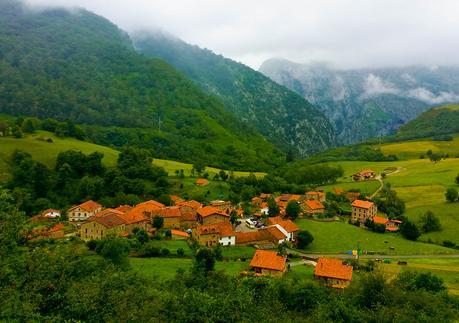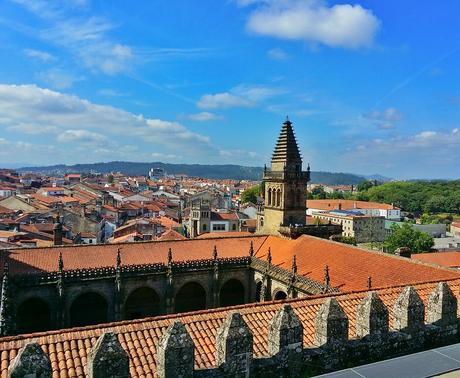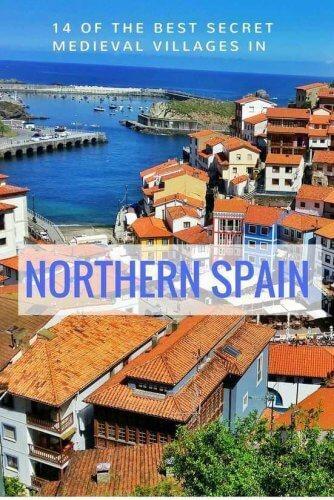If you haven't been to Northern Spain, you don't know what you're missing. While I loved the endless beaches and coastlines, the medieval villages and historic centres in towns and cities were also a highlight of my visit.
Unlike the famous villages of Cinque Terre in Italy, I had never heard of any of these villages. That's in part what makes them so special. Go now, and discover them before everyone else does.
Keep reading to check out my favourite villages and historic centres in Basque Country, Cantabria, Asturias and Galicia, also known as Green Spain.
Hondarribia:
This lovely town is known as the most beautiful in Basque Country. Within minutes, I could see why. While wandering through the Old Town, surrounded by a still standing fortified wall, it's easy to think you have slipped back in time. Besides the Old Town, Hondarribia also has a flourishing culinary scene, which is attracting chefs from around Spain. There's a wide choice of restaurants making it one of the best places to experience Basque gastronomy.
Pasai Donibane and Pasai San Pedro:
The Old Town of Pasai Donibane is a single cobblestone street that starts in the Bizkaia District and continues on to Alabortza Cove. You'll pass houses dating back to the 16th century and find a cozy cafe with views of the cove.
You can also take a really short boat ride to Pasai San Pedro to reach Albaola, a sea factory of the Basques. Here, you can learn all about whaling in Basque Country. Basque sailors were famous for their whaling skills going as far as Canada (my home country). It's worth a side trip if you're in the area. Travel tip: Albaola is closed on Mondays.
It's also a good place to watch how locals revel in the simple pleasures, like cooling off with a swim - and remind us that on a hot day, nothing is more refreshing than a cool dip!
Getaria
This fishing village on the Urola Coast has beaches on either side. I really enjoyed my visit to this village and could definitely have spent longer here. Fashionistas will want to visit the Cristóbal Balenciaga Museum, since Getaria the birthplace of the famed designer.
Mutriku
Dating back to the 13th century, Mutrkiku is an interesting place to wander through the narrow streets and check out interesting buildings, like the Galdona Palace. Also keep your eye open for houses with their own unique coats of arms.
Castro Urdiales
At first glance you'll notice what a modern seaside town Castro urdiales is. Upon a closer glance, you'll find that it still has a medieval historic centre and a Gothic church. Both are worth exploring. When the weather is nice watch, or join, local daredevils jumping off a bridge into a sheltered enclave.
Santillana del Mar
Santillana del Mar is one of the best preserved medieval towns in Cantabria, Spain! No wonder that the village centre is a National Monument. It's on the North Camino route and the Santa Juliana Church is a popular spot for pilgrims. I loved this place! It was easily one of my two favourite village in northern Spain!
Comillas
This seaside town had me saying WOW upon entering. Of note are the old buildings of Pontifical University, now relocated in Madrid. This is the finest architecture in town. That's saying a lot for a place that's also home to El Capricho, one of Gaudi's few works outside of Barcelona. While I stayed near Comillas, I unfortunately didn't spend more time in the town itself. Duncan of Urban Travel Blog did however, and declared it his favourite place in Cantabria.
Cicera

Surrounded by the Cantabrian mountains, Cicera's 68 inhabitants live the peaceful live. While I didn't count, it's quite possible that the residents are outnumbered by cats. You will pass it if you're hiking the Camino Lebaniego. There's a restaurant/bar where you can refuel.
Llanes
Llanes is a medieval fishing town with a fishing port that's still active today. It played an important part in the whale hunt. Fishermen used to stand on guard and watch for smoke signals from other fishermen. Once the smoke signal was observed, all the fishermen would go out and join them in smaller boats with their harpoons.
Llanes is also famous for its folklore and fiestas! In summer alone there are 4 notable festivals; N uestra Señora del Conceyu, which celebrates the patron saint of the town on August 15th. In addition, there are three additional fiestas: La Magdalena on July 22nd, San Roque on August 16th, and La Guía on September 8th. These fiestas have a long and well-known rivalry with each trying to outdo the others each year. The result is a summer of incredible festivals for both locals and tourists alike!
Oviedo
Despite not being a village, I've included Oviedo, the capital of Asturias for its unique history. It dates back to the 8th century when it was the capital of the Kingdom of Asturias. Centuries later, it still retains its medieval flair in the historic quarter. Of special note is Oviedo Cathedral, but unfortunately I arrived too late to visit.
Cudillero
This is a tie with Santillana del Mar for my favourite medieval village in northern Spain. It's reputation preceeds itself for being one of the most beautiful fishing villages in the country. But what I really loved about it, besides the incredible views, were how friendly the locals were. My limited Spanish consists of Más vino por favor (more wine please), but fortunately I was with some Spanish friends who were able to translate. I had the pleasure of meeting a 98-year-old lady who said she never tired of the view from her window after all these years. She had an aurora of peacefulness and was the kind of person that you feel more still just from being around her. It's easy to see why.
I also loved the self-guided tour, in which you follow the blue fish signs painted on the ground. Be warned, you will feel the burn. Cudillero is built on a hill. This village was also exceptional for cats which all appeared to be well fed - another plus for Cudillero!
Luarca
The highlight of Luarca is its harbour, which is one the most beautiful in the country. I really enjoyed walking around the fishing port. The winding narrow streets of the Old Town are also worth exploring.
Sobrado dos Monxes
The name of this town translates to Monks. That's rather fitting since the main highlight is the Cistercian Monastery of Santa Maria de Sobrado dos Monxes. It dates back to the 10th century and is a UNESCO World Heritage Site and is an important stop on the Camino de Santiago.
Santiago de Compostela
While Santiago is far from being a village, its UNESCO designated Old Town is one of the most beautiful urban areas you'll find anywhere on the planet! Architectural styles range from Romanesque, to Gothic to Baroque giving it a unique flair. You'll find many of the oldest buildings around the Santiago de Compostela Cathedral. The cathedral is also the finish point of the 780km long St. James Way and holds the remains of St. James himself.
I also highly recommend heading to the rooftop, available via tours only, for an incredible view over Santiago and beyond!

While these are my favourite medieval villages in northern Spain, I'm sure there are others I haven't discovered. Let me know in the comments below!


